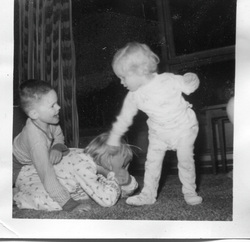Then, work with a partner and help them to dig deeper into their photograph descriptions--help him or her to find the story.
What is the story behind this photograph? What questions can you ask to help me dig deep? Look closely, notice EVERYTHING! Try to ask one small potato question and one big potato question. Next week, I'll share the answers and the story with you!
Then, work with a partner and help them to dig deeper into their photograph descriptions--help him or her to find the story. September 27 2010
A good writer listens well and asks questions that will help him or her to understand and clarify. Here a couple of quotations that I try to live by: You are not really listening if you aren’t willing to be changed by what you hear. Listening requires us to do only that—one cannot truly listen and be doing something else at the same time. To often, we listen to our friends, teachers, family etc while doing something else, or while thinking about what WE WANT TO SAY. I am quite guilty of doing both. But I try, every day, to do this a little better. I am always amazed about how just listening to someone else encourages them to tell me more--and I get to learn more. Asking questions that show I've really been listening really makes the other person feel like they've been heard. In the months ahead, you'll use the same principles when reading a classmate's writing or when interviewing someone you don't know about their concerns. Empathic listening and questioning takes practice--so in class we did just that. First we read Fifth Grade Autobiography by Rita Dove. She describes a photograph in the poem. After the exercise, we talked about what happened. Some students said that when they were listening completely it was like they could see the photograph. Other students said that they'd never been listened to so attentively. Still other students said that it was hard work but fun. With Your Partner--
The Speaker: Look directly at your partner. If you finish speaking before time is up, just sit quietly. The Listener: While the speaker is talking, listen only. Don’t comment or ask questions. Look directly at your partner. During the question round: Listener-- 1. Make sure you heard your partner right-- So, what I heard you saying is… 2. Ask a question of your partner that will get them to expand on what they said. Do you think… Do you feel… Do you hope… Speaker: Answer the questions as best you can. Assignment: Find the photograph and bring it in to class. Write a paragraph about the picture—is it the same as you remembered? If not, why do you think that is? How is it different? How do you feel when you look at the picture now? Fifth Grade Autobiography by Rita Dove I was four in this photograph fishing with my grandparents at a lake in Michigan. My brother squats in poison ivy. His Davy Crockett cap sits squared on his head so the raccoon tail flounces down the back of his sailor suit. My grandfather sits to the far right in a folding chair, and I know his left hand is on the tobacco in his pants pocket because I used to wrap it for him every Christmas. Grandmother's hips bulge from the brush, she's leaning into the ice chest, sun through the trees printing her dress with soft luminous paws. I am staring jealously at my brother; the day before he rode his first horse, alone. I was strapped in a basket behind my grandfather. He smelled of lemons. He's died-- but I remember his hands. Thumbs up! Ms. Kyles class divided into small groups and were given the instruction to arrange themselves by their thumbs. What? Yep. By their thumbs. After a few minutes to talk and come to an agreement about how they would do this, the students presented their "arrangement" by group. A couple lined up according to length of thumb, one group divided into two because half their group had thumbs which curved at the end, while the others were straight. Another group looked at the lines on the top of their thumbs and still another considered the color of their nails.
The students then sat down to talk about the process and make some observations about what it takes to have a successful group process. 1. Each person gets to talk. 2. Make sure everyone is invited to speak--invited SINCERELY. 3. Listen to everyone's ideas and include in discussion. 4. Explore ideas by looking at birthdays and seasons. (The class came up with these words to replace the traditional pros and cons. The offered words that had positive meanings and words represented change, rather than "bad." After a vote, the group chose birthdays and seasons.) We'll continue to explore community agreements. The students were then asked to examine their thumbs closely, from all angles, and do a quick sketch. A good writer takes notice very ACTIVELY. Lots of times, we assume we know something well, even something so close to us as our thumbs. The students looked at their thumbs and used their other senses as well. Even tasting! Assignment: Pretend your thumb can speak. What story would it tell about you and what voice would it use to tell the story. Write a paragraph ( or more). |

 RSS Feed
RSS Feed